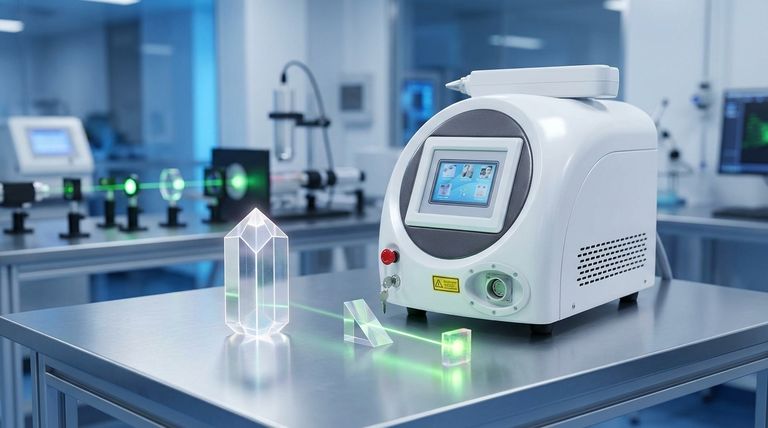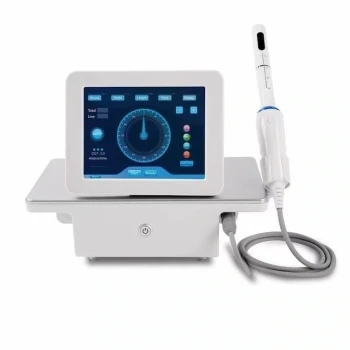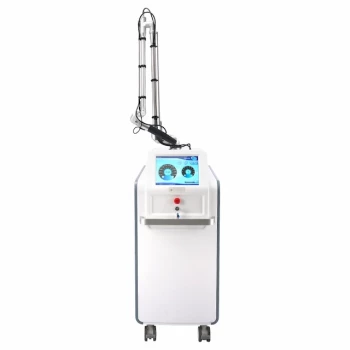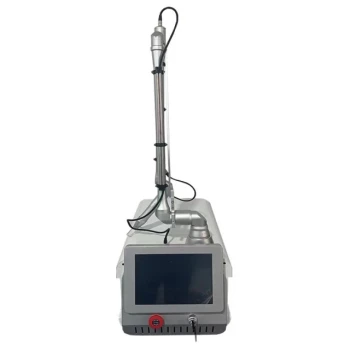At its core, Yttrium Aluminum Garnet (YAG) is a synthetic crystal composed of three primary elements: Yttrium (Y), Aluminum (Al), and Oxygen (O). This specific combination forms a stable, hard, and optically transparent material that serves as a foundational host for advanced applications, particularly in the field of optics and lasers.
While its base elements create the crystal, the true power of YAG is unlocked by what is added to it. Understanding YAG requires looking beyond its fundamental composition to the process of "doping," where trace amounts of other elements are intentionally introduced to give it remarkable new properties.

The Fundamental Structure of YAG
To understand YAG's role in technology, we must first look at how its core elements come together. The specific arrangement is just as important as the elements themselves.
The Elemental Composition
The chemical formula for YAG is Y₃Al₅O₁₂. This means that in a single formula unit of the crystal, there are three yttrium ions, five aluminum ions, and twelve oxygen ions. This precise ratio is critical for forming its unique structure.
The Garnet Crystal Lattice
These elements do not combine randomly. They arrange themselves into a highly ordered and stable cubic structure known as a garnet lattice. This crystal structure is responsible for YAG's excellent physical properties, including its high thermal conductivity and mechanical hardness, making it durable enough for high-power applications.
Why YAG is More Than Its Base Elements
Undoped, pure YAG is optically transparent and physically robust, but it is not a laser material on its own. Its value comes from its ability to act as a "host" for other optically active elements.
The Concept of Doping
Doping is the process of intentionally introducing a small, controlled amount of an impurity element into a pure crystal. In YAG, some of the yttrium atoms in the crystal lattice are deliberately replaced with atoms of another element, known as a dopant. This dopant is what gives the YAG crystal its functional properties, such as the ability to generate laser light.
Neodymium (Nd): The Key to High-Power Lasers
The most famous and widely used variant is Neodymium-doped YAG (Nd:YAG). By replacing a small percentage (around 1%) of the yttrium atoms with neodymium atoms, the crystal gains the ability to absorb energy from a pump source (like a flash lamp or diode) and release it as a coherent, powerful beam of infrared light at a wavelength of 1064 nm.
Other Common Dopants
The YAG host is versatile and can be doped with other rare-earth elements to produce different effects.
- Erbium (Er:YAG): Produces a laser wavelength highly absorbed by water, making it ideal for medical applications in dentistry and dermatology.
- Ytterbium (Yb:YAG): Offers high efficiency and is used in high-power diode-pumped solid-state lasers.
- Cerium (Ce:YAG): Does not lase but exhibits fluorescence. It is ground into a powder and used as a yellow phosphor in the manufacturing of white LEDs.
Understanding the Trade-offs
The performance of doped YAG is a delicate balance. Simply adding a dopant is not enough; the process involves critical trade-offs that engineers and scientists must manage.
Crystal Quality vs. Dopant Function
The base YAG crystal must be grown with exceptionally high purity and structural perfection. Any defects in the crystal lattice can scatter light and reduce efficiency. However, the entire point of doping is to introduce a "defect" (the dopant atom) that provides the desired optical function. The goal is a perfectly ordered crystal containing a precisely controlled, uniformly distributed "impurity."
Dopant Concentration Limits
There is an optimal concentration for each dopant. If too little is added, the laser's power and efficiency will be low. If too much dopant is added, a phenomenon called concentration quenching can occur. The dopant atoms get too close to each other, causing non-radiative energy loss and degrading the crystal's performance, sometimes preventing lasing entirely.
Applying This to Your Goal
Understanding YAG's composition allows you to appreciate why it is chosen for specific tasks. Your application dictates which version of YAG is required.
- If your primary focus is industrial manufacturing or materials processing: Your work almost certainly involves Nd:YAG lasers, valued for their power and versatility in cutting, welding, and marking.
- If your primary focus is medical technology: You will encounter Er:YAG for tissue ablation or Ho:YAG (Holmium-doped) for surgical procedures.
- If your primary focus is lighting or displays: You are interacting with Ce:YAG, the phosphor that makes the mass production of white LEDs possible.
- If your primary focus is materials science: You see pure YAG as an ideal host material, a stable and predictable crystalline "scaffold" for testing the properties of various rare-earth dopants.
By understanding that YAG's identity is defined by both its foundational crystal and its functional dopants, you can grasp its central role in modern technology.
Summary Table:
| YAG Component | Role | Key Characteristics |
|---|---|---|
| Base Crystal (Y₃Al₅O₁₂) | Host Structure | Stable garnet lattice, high thermal conductivity, mechanical hardness |
| Neodymium (Nd) | Primary Dopant | Enables 1064 nm laser emission for industrial cutting/welding |
| Erbium (Er) | Medical Dopant | Produces water-absorbed wavelength for dentistry/dermatology |
| Ytterbium (Yb) | Efficiency Dopant | High-power diode-pumped solid-state lasers |
| Cerium (Ce) | Phosphor Dopant | Yellow phosphor for white LED manufacturing |
Ready to leverage the power of YAG technology in your practice? BELIS specializes in professional medical aesthetic equipment, including advanced laser systems built on YAG crystals. Whether you run a medical aesthetics clinic or a premium beauty salon, our expertise ensures you get the right technology for cutting, welding, skin treatments, or hair removal. Contact our specialists today to discover how our YAG-based solutions can enhance your services and drive your business forward.
Visual Guide

Related Products
- Q Switch Nd Yag Laser Machine Tattoo Removal Nd Yag Machine
- Clinic Use IPL and SHR Hair Removal Machine with Nd Yag Laser Tattoo Removal
- Diode Laser SHR Trilaser Hair Removal Machine for Clinic Use
- 7D 12D 4D HIFU Machine Device
- Clinic Diode Laser Hair Removal Machine with SHR and Trilaser Technology
People Also Ask
- What are the disadvantages of Q switching? Trade-offs in Pulse Control, Cost, and Beam Quality
- What are Q-switched lasers commonly used for? Remove Tattoos & Pigment with Precision
- Is Q-Switch laser safe for skin? Achieve Precise, Non-Invasive Skin Rejuvenation Safely
- What are the side effects of Q-switch laser? A Guide to Safe, Effective Treatment
- Is Q Switched Nd:YAG laser good? The Gold Standard for Tattoo & Pigment Removal



















